Since
development started on the LMV in 1999, Iveco Defence
Vehicles Engineers have always recognised that the vehicle’s
design could not stand still. If it was to continue to
meet the evolving needs of the disparate 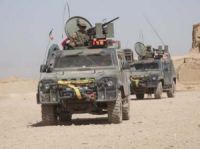 user
community, it was clear that the vehicle design team would
have to anticipate how requirements would develop and
put in place plans to meet them.In order to achieve this
goal, two prerequisites needed to be put in place: firstly,
the basic vehicle design would have to be sufficiently
robust and adaptable to accommodate significant design
changes, and, secondly, the design team would have to
be capable of making reasoned forecasts as to the likely
direction in which the user’s requirements would
move. The first of these goals was achieved through the
original LMV design which adopted a modular approach to
ballistic and mine protection, and incorporated a crew
cell mounted on to a purpose designed chassis. Both the
roof and the stowage pod are modular, enabling the vehicle
to be configured to meet the demands of different users
without altering the base design. The design team had
conceived the highly successful short wheel base (3220
mm) /four man cab as only the first of a family of vehicles,
and it was here, in anticipating the likely growth paths
of the user’s requirements, that the second prerequisite
was put in place. The design team anticipated not just
the inevitable demands for more payload, greater capacity
and higher levels of protection, but also foresaw the
need for a light protected utility design, and all the
variants which might derive from it.
user
community, it was clear that the vehicle design team would
have to anticipate how requirements would develop and
put in place plans to meet them.In order to achieve this
goal, two prerequisites needed to be put in place: firstly,
the basic vehicle design would have to be sufficiently
robust and adaptable to accommodate significant design
changes, and, secondly, the design team would have to
be capable of making reasoned forecasts as to the likely
direction in which the user’s requirements would
move. The first of these goals was achieved through the
original LMV design which adopted a modular approach to
ballistic and mine protection, and incorporated a crew
cell mounted on to a purpose designed chassis. Both the
roof and the stowage pod are modular, enabling the vehicle
to be configured to meet the demands of different users
without altering the base design. The design team had
conceived the highly successful short wheel base (3220
mm) /four man cab as only the first of a family of vehicles,
and it was here, in anticipating the likely growth paths
of the user’s requirements, that the second prerequisite
was put in place. The design team anticipated not just
the inevitable demands for more payload, greater capacity
and higher levels of protection, but also foresaw the
need for a light protected utility design, and all the
variants which might derive from it.
As a result, although the majority of the 2,000 + LMVs
sold to date are short wheel base vehicles in the original
configuration, the evolving demands of the user are increasingly
influencing the design team to focus 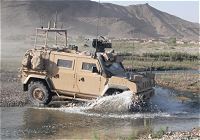 on
variants of the longer 3520 mm wheelbase design. Besides
enabling more room to be provided in the crew cell, this
variant can also incorporate a longer stowage pod, substantially
increasing the vehicle’s capacity. The inevitable
corollary of providing greater capacity is that the vehicle
has to support a higher usable payload than was originally
envisaged, and yet the move to a longer wheelbase with
a larger crew cell and higher levels of protection inevitably
pushes the kerb weight of the vehicle up. To counter this,
the design team has undertaken a series of design exercises
to both enable the GVW of the vehicle to be increased
and to take weight out of the vehicle design. As a result
of such expedients as incorporating an integral hard top
in place of a roll cage, altering the roof hatch design,
incorporating new seats and changing the design of the
transparent armour, the kerb weight of the vehicle has
been reduced by some 350 kgs. At the same time, the allowable
GVW of the vehicle has been increased from 7,000 to 7,500
kgs through developments on the frame, brakes and suspension.
The design team has thus succeeded in delivering to the
user a vehicle which, whilst retaining extensive commonality
with the earlier models, nonetheless provides greatly
increased capacity, payload and, if required, protection.
on
variants of the longer 3520 mm wheelbase design. Besides
enabling more room to be provided in the crew cell, this
variant can also incorporate a longer stowage pod, substantially
increasing the vehicle’s capacity. The inevitable
corollary of providing greater capacity is that the vehicle
has to support a higher usable payload than was originally
envisaged, and yet the move to a longer wheelbase with
a larger crew cell and higher levels of protection inevitably
pushes the kerb weight of the vehicle up. To counter this,
the design team has undertaken a series of design exercises
to both enable the GVW of the vehicle to be increased
and to take weight out of the vehicle design. As a result
of such expedients as incorporating an integral hard top
in place of a roll cage, altering the roof hatch design,
incorporating new seats and changing the design of the
transparent armour, the kerb weight of the vehicle has
been reduced by some 350 kgs. At the same time, the allowable
GVW of the vehicle has been increased from 7,000 to 7,500
kgs through developments on the frame, brakes and suspension.
The design team has thus succeeded in delivering to the
user a vehicle which, whilst retaining extensive commonality
with the earlier models, nonetheless provides greatly
increased capacity, payload and, if required, protection.
These design developments have allowed the LMV to move
beyond its established role as a protected liaison and
patrol vehicle, and provide the potential to the user
of a more flexible and capable family of vehicles, as
had originally been intended. The Spanish and Italian
armies have already taken delivery of long wheel base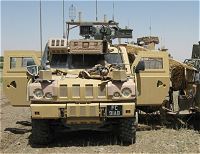 LMVs configured as casualty evacuation vehicles, whilst
the majority of Iveco’s current offerings are now
based on the 7.5 tonne GVW long wheel base platform. This
has also provided the basis for the development of solutions
for such programmes as the UK’s OUVS and LPPV programmes,
in both of which the LMV has provided the platform for
solutions which closely match the requirement. As
the vehicle is used in an increasing number of roles,
so the engineering challenges posed by adapting the base
design to match the customer needs become more demanding.
Often, it is just those design features which make the
vehicle particularly desirable for a given role, such
as low weight, narrow wheel track and high terrain accessibility,
which also add to the design challenge. A case in point
is the increasing requirement for heavier roof mounted
systems, including 12.7 mm overhead weapon stations and
other weapon systems. Whilst a relatively narrow vehicle
undoubtedly has excellent terrain accessibility and utility
in built up areas, the addition of weapon mounts beyond
a given weight can compromise stability. To counter this,
the design team have now developed hydropneumatic suspension
which substantially improves vehicle road-holding when
the vehicle has a relatively high centre of gravity.
LMVs configured as casualty evacuation vehicles, whilst
the majority of Iveco’s current offerings are now
based on the 7.5 tonne GVW long wheel base platform. This
has also provided the basis for the development of solutions
for such programmes as the UK’s OUVS and LPPV programmes,
in both of which the LMV has provided the platform for
solutions which closely match the requirement. As
the vehicle is used in an increasing number of roles,
so the engineering challenges posed by adapting the base
design to match the customer needs become more demanding.
Often, it is just those design features which make the
vehicle particularly desirable for a given role, such
as low weight, narrow wheel track and high terrain accessibility,
which also add to the design challenge. A case in point
is the increasing requirement for heavier roof mounted
systems, including 12.7 mm overhead weapon stations and
other weapon systems. Whilst a relatively narrow vehicle
undoubtedly has excellent terrain accessibility and utility
in built up areas, the addition of weapon mounts beyond
a given weight can compromise stability. To counter this,
the design team have now developed hydropneumatic suspension
which substantially improves vehicle road-holding when
the vehicle has a relatively high centre of gravity.
One of the most pressing
design requirements which is now being encountered is
the almost insatiable demand for ever greater levels of
on-board electrical power. This is driven principally
by the need to power communications and onboard ECM equipment
and is very significantly in excess of original planning
assumptions. Where once a 200 A alternator might have
been sufficient, even generous, now 300 A is the threshold
level, and there is no doubt that this will rise further
in the future. Although much can be achieved with the
most recent generation of high efficiency alternators,
it appears likely that a more radical approach may be
required in the future. Here, too, Iveco’s engineers
are well positioned because the LMV engine already provides
the basis for a commercially available hybrid electric
drive system. This promises to provide the opportunity
to deliver high levels of electrical power in the future,
and presents limited technical risk as the system is already
in commercial use.






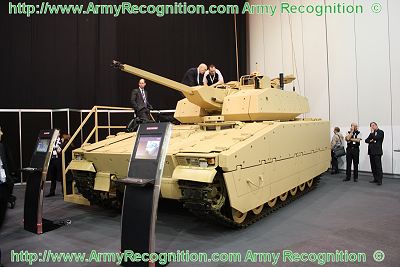
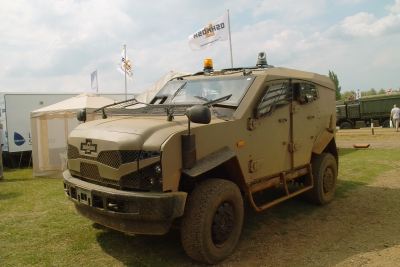
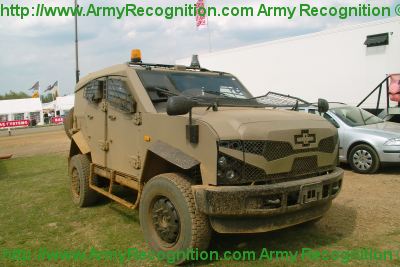
 user
community, it was clear that the vehicle design team would
have to anticipate how requirements would develop and
put in place plans to meet them.In order to achieve this
goal, two prerequisites needed to be put in place: firstly,
the basic vehicle design would have to be sufficiently
robust and adaptable to accommodate significant design
changes, and, secondly, the design team would have to
be capable of making reasoned forecasts as to the likely
direction in which the user’s requirements would
move. The first of these goals was achieved through the
original LMV design which adopted a modular approach to
ballistic and mine protection, and incorporated a crew
cell mounted on to a purpose designed chassis. Both the
roof and the stowage pod are modular, enabling the vehicle
to be configured to meet the demands of different users
without altering the base design. The design team had
conceived the highly successful short wheel base (3220
mm) /four man cab as only the first of a family of vehicles,
and it was here, in anticipating the likely growth paths
of the user’s requirements, that the second prerequisite
was put in place. The design team anticipated not just
the inevitable demands for more payload, greater capacity
and higher levels of protection, but also foresaw the
need for a light protected utility design, and all the
variants which might derive from it.
user
community, it was clear that the vehicle design team would
have to anticipate how requirements would develop and
put in place plans to meet them.In order to achieve this
goal, two prerequisites needed to be put in place: firstly,
the basic vehicle design would have to be sufficiently
robust and adaptable to accommodate significant design
changes, and, secondly, the design team would have to
be capable of making reasoned forecasts as to the likely
direction in which the user’s requirements would
move. The first of these goals was achieved through the
original LMV design which adopted a modular approach to
ballistic and mine protection, and incorporated a crew
cell mounted on to a purpose designed chassis. Both the
roof and the stowage pod are modular, enabling the vehicle
to be configured to meet the demands of different users
without altering the base design. The design team had
conceived the highly successful short wheel base (3220
mm) /four man cab as only the first of a family of vehicles,
and it was here, in anticipating the likely growth paths
of the user’s requirements, that the second prerequisite
was put in place. The design team anticipated not just
the inevitable demands for more payload, greater capacity
and higher levels of protection, but also foresaw the
need for a light protected utility design, and all the
variants which might derive from it. on
variants of the longer 3520 mm wheelbase design. Besides
enabling more room to be provided in the crew cell, this
variant can also incorporate a longer stowage pod, substantially
increasing the vehicle’s capacity. The inevitable
corollary of providing greater capacity is that the vehicle
has to support a higher usable payload than was originally
envisaged, and yet the move to a longer wheelbase with
a larger crew cell and higher levels of protection inevitably
pushes the kerb weight of the vehicle up. To counter this,
the design team has undertaken a series of design exercises
to both enable the GVW of the vehicle to be increased
and to take weight out of the vehicle design. As a result
of such expedients as incorporating an integral hard top
in place of a roll cage, altering the roof hatch design,
incorporating new seats and changing the design of the
transparent armour, the kerb weight of the vehicle has
been reduced by some 350 kgs. At the same time, the allowable
GVW of the vehicle has been increased from 7,000 to 7,500
kgs through developments on the frame, brakes and suspension.
The design team has thus succeeded in delivering to the
user a vehicle which, whilst retaining extensive commonality
with the earlier models, nonetheless provides greatly
increased capacity, payload and, if required, protection.
on
variants of the longer 3520 mm wheelbase design. Besides
enabling more room to be provided in the crew cell, this
variant can also incorporate a longer stowage pod, substantially
increasing the vehicle’s capacity. The inevitable
corollary of providing greater capacity is that the vehicle
has to support a higher usable payload than was originally
envisaged, and yet the move to a longer wheelbase with
a larger crew cell and higher levels of protection inevitably
pushes the kerb weight of the vehicle up. To counter this,
the design team has undertaken a series of design exercises
to both enable the GVW of the vehicle to be increased
and to take weight out of the vehicle design. As a result
of such expedients as incorporating an integral hard top
in place of a roll cage, altering the roof hatch design,
incorporating new seats and changing the design of the
transparent armour, the kerb weight of the vehicle has
been reduced by some 350 kgs. At the same time, the allowable
GVW of the vehicle has been increased from 7,000 to 7,500
kgs through developments on the frame, brakes and suspension.
The design team has thus succeeded in delivering to the
user a vehicle which, whilst retaining extensive commonality
with the earlier models, nonetheless provides greatly
increased capacity, payload and, if required, protection. LMVs configured as casualty evacuation vehicles, whilst
the majority of Iveco’s current offerings are now
based on the 7.5 tonne GVW long wheel base platform. This
has also provided the basis for the development of solutions
for such programmes as the UK’s OUVS and LPPV programmes,
in both of which the LMV has provided the platform for
solutions which closely match the requirement. As
the vehicle is used in an increasing number of roles,
so the engineering challenges posed by adapting the base
design to match the customer needs become more demanding.
Often, it is just those design features which make the
vehicle particularly desirable for a given role, such
as low weight, narrow wheel track and high terrain accessibility,
which also add to the design challenge. A case in point
is the increasing requirement for heavier roof mounted
systems, including 12.7 mm overhead weapon stations and
other weapon systems. Whilst a relatively narrow vehicle
undoubtedly has excellent terrain accessibility and utility
in built up areas, the addition of weapon mounts beyond
a given weight can compromise stability. To counter this,
the design team have now developed hydropneumatic suspension
which substantially improves vehicle road-holding when
the vehicle has a relatively high centre of gravity.
LMVs configured as casualty evacuation vehicles, whilst
the majority of Iveco’s current offerings are now
based on the 7.5 tonne GVW long wheel base platform. This
has also provided the basis for the development of solutions
for such programmes as the UK’s OUVS and LPPV programmes,
in both of which the LMV has provided the platform for
solutions which closely match the requirement. As
the vehicle is used in an increasing number of roles,
so the engineering challenges posed by adapting the base
design to match the customer needs become more demanding.
Often, it is just those design features which make the
vehicle particularly desirable for a given role, such
as low weight, narrow wheel track and high terrain accessibility,
which also add to the design challenge. A case in point
is the increasing requirement for heavier roof mounted
systems, including 12.7 mm overhead weapon stations and
other weapon systems. Whilst a relatively narrow vehicle
undoubtedly has excellent terrain accessibility and utility
in built up areas, the addition of weapon mounts beyond
a given weight can compromise stability. To counter this,
the design team have now developed hydropneumatic suspension
which substantially improves vehicle road-holding when
the vehicle has a relatively high centre of gravity.








